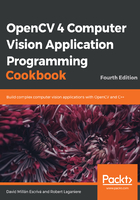
How it works...
One way to define an ROI is to use a cv::Rect instance. As the name indicates, it describes a rectangular region by specifying the position of the upper-left corner (the first two parameters of the constructor) and the size of the rectangle (the width and height are given in the last two parameters). In our example, we used the size of the image and the size of the logo in order to determine the position where the logo would cover the bottom-right corner of the image. Obviously, the ROI should always be completely inside the parent image.
The ROI can also be described using row and column ranges. A range is a continuous sequence from a start index to an end index (excluding both). The cv::Range structure is used to represent this concept. Therefore, an ROI can be defined from two ranges; in our example, the ROI could have been equivalently defined as follows:
imageROI= image(cv::Range(image.rows-logo.rows,image.rows),
cv::Range(image.cols-logo.cols,image.cols));
In this case, the operator() function of cv ::Mat returns another cv::Mat instance that can then be used in subsequent calls. Any transformation of the ROI will affect the original image in the corresponding area because the image and the ROI share the same image data. Since the definition of an ROI does not include the copying of data, it is executed in a constant amount of time, no matter the size of the ROI.
If one wants to define an ROI made of some lines of an image, the following call could be used:
cv::Mat imageROI= image.rowRange(start,end);
Similarly, for an ROI made of some image columns, the following could be used:
cv::Mat imageROI= image.colRange(start,end);